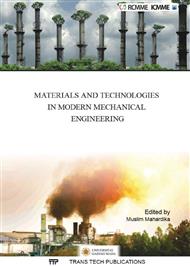[1]
Bold, H.C. and M. J. Wynne. Introduction to the algae: structure and reproduction, second ed, Prentice Hal Inc., Englewood Cliff, New York, 1985, pp.141-142.
Google Scholar
[2]
Liu, J., Z. Sun, H. Gerken, Z. Liu, Y. Jiang and F. Chen, Chlorella zofingiensis as an alternative microalgal producer of astaxanthin: biology and industrial potential, Marine drugs, 12 (2014) 3491-3492.
DOI: 10.3390/md12063487
Google Scholar
[3]
Rhodes, D and A. D. Hanson, Quaternary ammonium and tertiary sulfonium compounds in higher plants, Annual review of plant physiology and plant molecular biology, 44 (1993) 357–384.
DOI: 10.1146/annurev.pp.44.060193.002041
Google Scholar
[4]
Feng, P., Z. Deng., L. Fan., and Z. Lu, Lipid accumulation and growth characteristics of chlorella zofingiensis under different nitrate and phosphate concentrations, Journal of bioscience and bioengineering, 114 (2012) 405-410.
DOI: 10.1016/j.jbiosc.2012.05.007
Google Scholar
[5]
Illman, A. M., A. H. Scragg and S. W. Shales, Increase in Chlorella strains calorific values when grown in low nitrogen medium, Enzyme and microbial technology, 27 (2000) 631-635.
DOI: 10.1016/s0141-0229(00)00266-0
Google Scholar
[6]
Scragg, A. H., A. M. Illman, A. Carden and S. W. Shales, Growth of microalgae with increased caloric values in a tubular bioreactor, Biomass and bioenergy, 23 (2002) 67-73.
DOI: 10.1016/s0961-9534(02)00028-4
Google Scholar
[7]
Klein, R. M, Effect of green light on biological systems, Biological review, 67 (1992) 199-284.
Google Scholar
[8]
Koc, C., G. A. Anderson and A. Kommareddy, Use of red and blue light-emitting diodes (LED) and fluorescent lamps to grow microalgae in a photobioreactor, The israeli journal of aquaculture, 65 (2012) 1-8.
DOI: 10.46989/001c.20661
Google Scholar
[9]
Campbell, N. A., J. B. Reece, L. A. Urry, M. L. Cain, S. A. Wasserman, P. V. Minoskry and R. B. Jackson, Biology, eighth ed, Benjamin Cummings, San Francisco USA, 2008, pp.185-199.
Google Scholar
[10]
Rivkin, R. B, Influence of irradiance and spectral quality on the carbon metabolism of phytoplankton, Marine ecology progress series, 55 (1989) 291-304.
DOI: 10.3354/meps055291
Google Scholar
[11]
Suyono, E.A. Aminin, Pradani, L., Mu'avatun, U., Habiba, R.N., Ramdaniyah, Rohma, E.F. Combination of blue, red, white, and ultraviolet lights for increasing carotenoids and biomass of Microalga Haematococcus pluvialis. Procedia Environmental Sciences 28 (2015).
DOI: 10.1016/j.proenv.2015.07.049
Google Scholar
[12]
Suyono, E.A. and Samudra. Growth And Lipid Content of Microalgae Tetraselmis Sp. Cuture Using Combination of Red blue Light and Nitrogen Starvationas An Effort to Increase Biodiesel Production, Asian Journal of Microbiology, Biotechnology and Environmental Science. 17 (1) (2015).
Google Scholar
[13]
Shu, C. H., C. C. Tsai, W. H. Liao, K. Y. Chen and H. C. Huang, Effect of light on the accumulation of oil in a mixed culture of Chlorella sp. and Saccharomyces cerevisiae, Journal of chemical technology and biotechnology, 87 (2012) 601-607.
DOI: 10.1002/jctb.2750
Google Scholar
[14]
Chen, P., M. Min, Y. Chen, L. Wang, Y. Li, Q. Chen, C. Wang, Y. Wang, X. Wang, Y. Chen, S. Deng, K. Hennessy, X. Lin, Y. Lui, Y. Wang, B. Martinez and R. Ruan, Review of the biological and engineering aspects of algae to fuels approach, International journal of agriculture and biology, 2 (2009).
Google Scholar
[15]
Lee, C. and B. Palsson. 1996. Photoacclimation of Chlorella vulgaris to red light from light-emitting diodes leads to autospore release following each cellular division, Biotechnology progress, 12 (1996) 249-256.
DOI: 10.1021/bp950084t
Google Scholar
[16]
Derenne, S., P. Metzger, C. Largeau, P.F. Van Berge, J.P. Gatellier, J.S. S Damste, J.W. De Leeuw and C. Berkaloff, Similar morphological and chemical variations of in ordovician sediments and cultured Botryococcus braunii as a response to changes in salinity, Organic geochemistry, 19 (1992).
DOI: 10.1016/0146-6380(92)90001-e
Google Scholar
[17]
Carpenter, A.E., T.R. Jones, M. R. Lamprecht, C. Clarke, I. H. Kang, O. Friman, D. A. Guertin, J. H. Chang, R. A. Lindquist and J. Moffat, CellProfiler: Image analysis software for identifying and quantifying cell phenotypes. Genome biology. 7 (2006).
DOI: 10.1186/gb-2006-7-10-r100
Google Scholar
[18]
Figueroa, F. L., J. Aguilera and F. X. Niell, Red and blue light regulation of growth and photosynthetic metabolism in Porphyra umbilicalis (Bangiales, Rhodophyta), European journal of phycology, 30 (1995) 11-18.
DOI: 10.1080/09670269500650761
Google Scholar
[19]
Richmond, A., Handbook of microalgal culture: biotechnology and applied phycology, Blackwell Science, India, 2004, p.3, 83-89.
Google Scholar
[20]
Wang, Z. T., N. Ullrich, S. Joo, S. Waffenschmidt and U. Goodenough, Algal lipid bodies: stress induction, purification and biochemical characterization in wild-type and starchless Chlamydomonas reinhardtii, Eukaryot cell, 8 (2009) 1856-1868.
DOI: 10.1128/ec.00272-09
Google Scholar
[21]
Bartley, M. L., W. J. Boeing, A. A. Corcoran, F. O. Holguin and T. Schaub, Effects of salinity on growth and lipid accumulation of biofuel microalga Nannochloropsis salina and invading organisms, Biomass and Bioenergy, 54 (2013) 83-88.
DOI: 10.1016/j.biombioe.2013.03.026
Google Scholar
[22]
Senge, M. and H. Senger, Adaptation of photosynthetic apparatus of Chlorella and Ankistrodesmas to blue and red light, Botanica Acta, 104 (1991) 139-143.
DOI: 10.1111/j.1438-8677.1991.tb00209.x
Google Scholar
[23]
Voskresenskaya, N. P, Blue light and carbon metabolism, Annual review of plant physiology, 23 (1972) 219-234.
DOI: 10.1146/annurev.pp.23.060172.001251
Google Scholar
[24]
Taher, H., S. Al-Zuhair, A. H. Al-Marzouqi, Y. Haik and M. Farid, Effective extraction of microalgae lipids from wet biomass for biodiesel production, Biomass and bioenergy, 66 (2014) 159-167.
DOI: 10.1016/j.biombioe.2014.02.034
Google Scholar
[25]
Sharma, K. K., H. Schuhmann and P. M. Schenk, High lipid induction in microalgae for biodisel production, Energies, 5 (2012) 1532-1553.
DOI: 10.3390/en5051532
Google Scholar
[26]
Juneja, A., R. M. Ceballos and G. S. Murty, Effects of environmental factors and nutrient availability on the biochemical composition of algae for biofuels production, Energies, 6 (2013) 4607-4638.
DOI: 10.3390/en6094607
Google Scholar
[27]
Wu, X. and J. C. Merchuk, A model integrating fluid dynamics in photosynthesis and photoinhibition processes, Chemical engineering science, 56 (2001) 3527–3538.
DOI: 10.1016/s0009-2509(01)00048-3
Google Scholar


